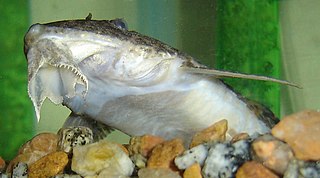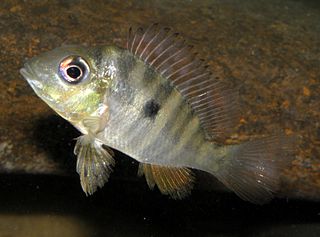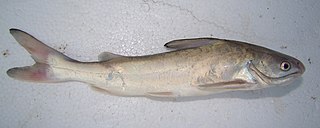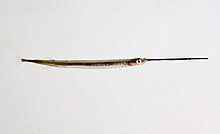
Otocinclus is a genus of catfish in the family Loricariidae native to South America, commonly known as "dwarf suckers" or "otos". This genus, like other loricariids, is characterized by rows of armour plating covering the body, as well as the underslung suckermouth. They are generally small in size; O. tapirape is the smallest of the species (2.4 cm), while O. flexilis is the biggest (5.5 cm). These species have adaptations that allow them to breathe air. A duct forms at the junction between the esophagus and the stomach and expands into an enlarged, ring-like diverticulum, characteristic of this genus, which allows air-breathing. Otocinclus are popular aquarium fish, and they are often purchased as algae eaters. It is difficult to breed them in captivity, and only wild caught Otocinclus are available to hobbyists. This genus is widely distributed east of the Andes of South America, throughout the lowlands from northern Venezuela to northern Argentina, but are generally absent from the Amazon and the Orinoco lowlands.

Pygocentrus is a genus of the piranha family Serrasalmidae. All species are native to tropical and subtropical South America. All the species are predatory, scavengers and may form large schools. The famous red-bellied piranha, Pygocentrus nattereri, is one of four species in the genus.

Mikrogeophagus is a genus of small cichlids native to the Amazon and Orinoco basins in South America. Both species are popular with aquarists, especially M. ramirezi.

Glass knifefishes are fishes in the family Sternopygidae in the order Gymnotiformes. Species are also known as rattail knifefishes.
Acestridium is a genus of freshwater fish in the family Loricariidae of order Siluriformes. The type species is Acestridium discus. The genus name is derived from Latinised Greek 'agkistron' meaning hook.

Callichthys is a small genus of freshwater catfish in the Callichthyinae subfamily of the armored catfish family, and consists of 4 species from South America. The genus Callichthys is distributed in most freshwater drainages of South America.

Rineloricaria is a genus of freshwater tropical catfish belonging to the family Loricariidae. They are commonly called whiptail catfish because of the long filament that grows out of the tip of the caudal fin that is characteristic of the genus. With the exception of R. altipinnis from Panama, they are native to the rivers of northern and central South America. Some species are regularly seen in the aquarium trade.

Gymnogeophagus is a genus of cichlid fishes from South America, where they are known from various river basins in southern Brazil, Paraguay, Uruguay and northern Argentina. They are part of a group popularly known as eartheaters.

Laetacara is a small genus of cichlids native to freshwater habitats in tropical and subtropical South America, ranging from the upper Orinoco River basin in Venezuela to the Paraná River basin Argentina. The genus is also collectively known as the smiling acaras. Like all cichlids, Laetacara species have well-developed brood care.

Mesonauta, the flag cichlids, is a small genus of cichlids native to the Amazon, Orinoco, Essequibo, Paraná and Paraguay basins in South America. Mesonauta is included in the subfamily Cichlasomatinae. They occur in various freshwater habitats such as streams and lakes, especially in areas with little water movement and aquatic vegetation. They are generally found in small groups that stay near the water surface. To avoid predators, adults may jump out of the water and juveniles mimic leaves.

Phalloceros is a genus of poeciliids native to freshwater habitats in Brazil, Paraguay, Uruguay and northern Argentina. The majority are endemic to southern and southeastern Brazil. P. caudimaculatus has long been part of the aquarium industry and has been introduced to countries far from its native range.
Lepthoplosternum is a small genus of freshwater catfish in the Callichthyinae subfamily of the armored catfish family.

Megalechis is a small genus of freshwater catfish in the Callichthyinae subfamily of the armored catfish family.
Hisonotus is a genus of armored catfishes native to South America. Species of Hisonotus and Curculionichthys are the only representatives of the subfamily Otothyrinae having serrae on the posterior edge of the pectoral fin spine. These species are small fishes, generally found in small fast flowing streams, where they grasp to the branches and leaves of aquatic or subaquatic plants. The species of this genus mostly occur in Atlantic coastal streams of southern Brazil and the Paraguay-Paraná system of southern South America. They are also distributed in the Río de La Plata basin and coastal rivers of southeastern Brazil.
Pareiorhaphis is a genus of catfish in the family Loricariidae native to South America. This genus can be readily distinguished from other neoplecostomines by the unique combination of having fleshy lobes on lateral margins of head ornamented with hypertrophied odontodes on nuptial males, caudal peduncle ovoid in cross section, abdomen usually naked, dorsal fin spinelet ovoid and adipose fin usually present. The color pattern is usually dark brown and mottled with the abdomen white. Most species in to Pareiorhaphis were originally described in Hemipsilichthys. In 1918, Alípio de Miranda-Ribeiro proposed the new genus Pareiorhaphis. Whether Pareiorhaphis is monophyletic or not is currently unknown.
Micromyzon is a genus of tiny catfish in the family Aspredinidae native to relatively deep parts of the Amazon and Orinoco basins in South America.

Poptella is a genus of fish in the characin family found in tropical South America, with four currently described species:

Genidens is a genus of sea catfishes found along the Atlantic coast of South America. There are currently four recognized species in this genus.
Plesioptopoma curvidens is a species of armored catfish native to Brazil, where it is known to occur in the Rio Paraopeba, a tributary of the Rio São Francisco. It is the only species in the genus Plesioptopoma. This species reaches a maximum length of 8.3 centimetres (3.3 in) (SL).

Phallotorynus is a genus of poeciliids native to southern Brazil, northern Argentina, and Paraguay.














